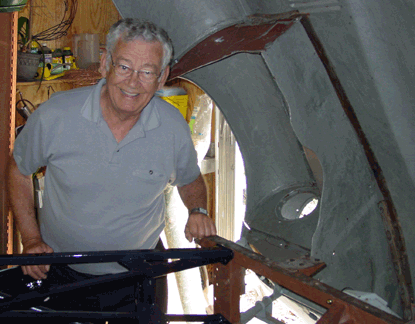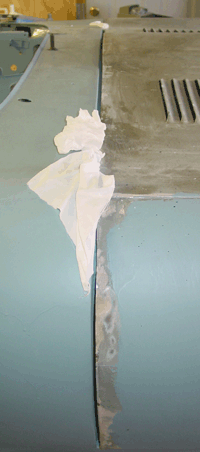Bonnet test fit
The garage had a very special visitor over this weekend. My dad, Wallace DeLong, came up to North Carolina after making the rounds through Florida to see relatives and participate in a travel exchange with people in Sarasota. I was a little worried about suggesting that we take on a project with the old car, since I didn’t want to impose my restoration work on an unwilling participant, but it actually turned out that Dad wanted to do exactly that.
through Florida to see relatives and participate in a travel exchange with people in Sarasota. I was a little worried about suggesting that we take on a project with the old car, since I didn’t want to impose my restoration work on an unwilling participant, but it actually turned out that Dad wanted to do exactly that.
As I mentioned before, Stefan Roundy provided a fine replacement for the bent bonnet subframe. That piece, along with the replacement left subframe from Bill McKenna, meant that the front frame could be put together with sound pieces. The bent up bonnet frame meant that the bonnet itself hung badly, and I was anxious to see whether the new bonnet subframe would straighten out the bonnet fit.
So, Dad and I installed the front subframes and mounted the bonnet on its hinges.
It fit squarely off the front bulkhead (firewall), though the bonnet measured just shy of an inch forward of the bulkhead — a bit too wide a space. We figured we needed to get the space to about a third of that.
We made some makeshift shims to insert into the hinges at the top. Basically, to bring the bonnet back, we had to make sure that the hinges were tightened until the hinge touched the area on the lower valance where they fit. No shims there — we needed to get the bonnet back as far as possible. Shims at that point would move the bonnet forward. Once we had done that, checked to see how the  bonnet fit against the lower sections of the bulkhead and the upper sections. Things were slightly wider at the upper part than at the lower, meaning that we could raise the bonnet to even things out.
bonnet fit against the lower sections of the bulkhead and the upper sections. Things were slightly wider at the upper part than at the lower, meaning that we could raise the bonnet to even things out.
We did the raising in two ways: we raised the bonnet subframe by inserting a small shim between the subframe and the “picture frame” at the lower connections. And we placed shims over the top section of the bonnet hinge that pivots on the subframe. These two things did the trick. I do not think both will be necessary when we actually fit the bonnet after the suspension is in place, since the dynamics of the frame will change, and the bonnet subframe will probably sit slightly higher as a result. Roger Los mentioned that his bonnet fitting was simplified after installing the suspension pieces that fit into the picture frame. When I first read that, I felt it might be a little dubious, but seeing how the structure fits and acts when bolted down, it is very probable that the rigidity of those pieces will support the frame in the right places, with the result that shimming will be less of an issue. I think we’ll still need to shim upward, though.
The final gap between the rear of the bonnet and the front bulkhead ended up being about 3/8 inch — about a half centimeter, a little wider perhaps. I’m reluctant to go much narrower than this, simply because the thickness of the primer and paint will make things a little tighter. The gap is about right. It is amazing to see what a new bonnet subframe will do to the gap, at any rate. When we first mounted the bonnet back in August of last year, the gap was a crooked disaster.
Front suspension parts for plating
Although I didn’t subject my dad to the gritty glories of sandblasting, we did weigh and organize the front suspension pieces that are due for nickel plating. There is still one suspension fitting that needs disassembly and cleaning. It has resisted my efforts to extract some pretty rusty bolts. It’s soaking in penetrating fluid now. We have 64 pounds (about 30 kilograms) of metal to be plated. I’ve decided not to send off small parts like washers and nuts. These I will probably plate myself, as I’m leaning toward ordering a nickel plating kit from Caswell Plating. Bill McKenna says it’s actually less putzy than zinc plating, and that seemed simple enough.
The platers is located in Fayetteville, North Carolina, and UPS wanted almost $90 USD to ship the parts. I figure that the trip will be a pleasant drive, and I should know what the charge will be without having to spend $180 USD on shipping, roundtrip.

Cylinder head cleanup
The final thing we did was clean up the insides of the cylinders where the valves are located. Five of the six chambers had a good deal of grime in them, and the remaining one (number one) was not too bad — which made me suspicious. I think that the fuel mix was set rich, probably to avoid pinging? Wire brush attachments to the drill made quick work of the grime. The valves were obviously in good shape, and my dad and I wondered if the valves were recently replaced in an overhaul. Dad looked pretty closely at cylinder wear and the valves and felt that the last overhaul wasn’t that long ago, and the engine didn’t require a massive amount of work. We did not look closely at the crankshaft (most of which is still in place), and there is a high probability (in my mind at least) that the rebuild of the engine was focused on the top, and not the bottom. Even though the bearings for the piston rods weren’t bad, the keys in my mind are the crankshaft bearings. After all, it’s fairly easy to replace rod bearings, but to replace the crankshaft bearing you have to remove the crankshaft. Wear related to that is heavier on this engine, so I’m suspicious. When we get to the engine in earnest, the crankshaft comes off and the measuring begins.
Here’s what the chambers looked like after some cleaning:
